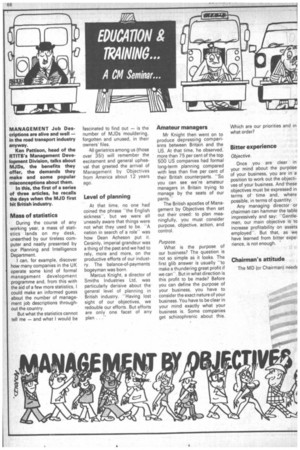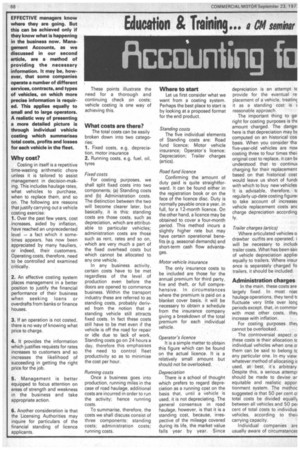Ken PattWon, RTITB
Page 73

Page 72

Page 74

If you've noticed an error in this article please click here to report it so we can fix it.
WHIN DID YOU LAST SEE YOUR MID...?
MANAGEMENT Job Descriptions are alive and well — in the road transport industry anyway.
Ken Pattison, head of the RTITB's Management Development Division, talks about MJDs, the benefits they offer, the demands they make and some popular misconceptions about them.
In this, the first of a series of three articles, he recalls the days when the MJD first hit British industry.
Mass of statistics
During the course of any working year, a mass of statistics lands on my desk, unearthed by our tireless computer and neatly presented by our Planning and Intelligence Department.
I can, for example, discover how many companies in the UK operate some kind of formal management development programme and, from this with the aid of a few more statistics, I could make an informed guess about the number of management job descriptions throughout the country.
But what the statistics cannot tell me — and what I would be fascinated to find out — is the number of MJDs mouldering, forgotten and unused, in their owners' files.
All geriatrics among us (those over 35!) will remember the excitement and general upheaval that greeted the arrival of Management by Objectives from America about 12 years ago.
Level of planning
At that time, no one had coined the phrase "the English sickness", but we were all uneasily aware that things were not what they used to be. ''A nation in search of a role" was how Dean Acheson put it. Cerainly, imperial grandeur was a thing of the past and we had to rely, more and more, on the productive efforts of our industry. The balance-of-payments bogeyman was born.
Marcus Knight, a director of Smiths Industries Ltd, was particularly derisive about the general level of planning in British industry. "Having lost sight of our objectives, we redouble our efforts. But efforts are only one facet of any plan .
Amateur managers
Mr Knight then went on to produce depressing comparisons between Britain and the US. At that time, he observed, more than 75 per cent of the top 500 US companies had formal long-term planning compared with less than five per cent of their British counterparts. "So you can see we're amateur managers in Britain trying to manage by the seats of our pants."
The British apostles of Management by Objectives then set out their creed: to plan meaningfully, you must consider purpose, objective, action, and control.
Purpose.
What is the purpose of our business? The question is not so simple as it looks. The first glib answer is usually "to make a thundering great profit if we can". But in what direction is this profit to be made? Before you can define the purpose of your business, you have to consider the exact nature of your business. You have to be clear in your mind exactly what your business is. Some companies get schizophrenic about this. Which are our priorities and in what order?
Bitter experience
Objective.
Once you are clear in your mind about the purpose of your business, you are in a position to work out the objectives of your business, And these objectives must be expressed in terms of time and, where possible, in terms of quantity.
Any managing director or chairman can hammer the table impressively and say: ''Gentlemen, our main objective is to increase profitability on assets employed". But that, as we have learned from bitter experience, is not enough.
Chairman's attitude
The MD (or Chairman) needE to be quantitive and time-based in his thinking. He needs to say, slowly and with the authority of facts behind him: "Gentlemen, our main objective is to increase our profitability from x per cent on Ey assets employed, to x + eight per cent on Ez assets employed by 19--."
Action A specific statement like this, a statement expressed in terms of quantity and time, involves action. Somebody has to review the company's markets, products, sales organisations and methods, production facilities and techniques. In the large company, these chores can be delegated
Is it worth it?
In the small company (and it is the small company that makes up most of the road transport industry) the chore has to be shouldered by the boss, helped by a small office staff. Is it worth it for the small operation: I shall have more to say about this in a later article.
Control So you have determined your plan of action. Now, you are going to put it into operation. How will you monitor its progress? What evidence will you have that your plan is — or is not — meeting its objectives: You will need documents, control documents, to show you targets exceeded, targets met and targets failed. And, where you don't have such documents, you will have to create them.
If you are under 35 (and, therefore, a non-geriatric!) I invite you to exercise your imagination. I invite you to think what it must have been like in Britain when Management by Objectives first hit us in the mid-Sixties
Throw it away
I invite you first to put yourself in the position of a Chairman (or MD) of any company of any size. If you were lucky enough to be in a business that was doing well, you could afford to ignore the whole thing. "Another piece of new-fangled nonsense from the academic boys. I suppose they have to earn a living. Chuck it in the waste-paper basket . .
Chairmen and MDs on the lookout for "a better mousetrap" — together with a few of the more long-sighted — were more responsive. "You know I think they've got something here. Look into it, will you?"
The people who were instructed to "look into it" were usually senior management of largish companies (the smaller fry were too busy managing "by the seat of their pants").
Hard to grasp
It would be pleasant to record that all the senior managers in British industry at once grasped the grand strategy of MBO — purpose, objective, action, control. Some undoubtedly did. But a lot did not. Purpose and objective proved hard nettles to grasp and, without these, no meaningful action plan could be developed; not on a corporate scale at least.
But what many of them could and did seize on was the concept of Control that MBO put forward.
The control document that aroused particular interest was the Management Job Description. Here, at long last, was an instrument by which a manager's performance could be objectively measured. Here was a means of separating the wheat from the chaff. A great idea. The best thing since reclinable car seats.
Out . Out of context
And so, the MJD was frequently introduced out of its proper context, not as a means towards a larger end but as an end in itself. Individual managers' targets were often set without any reference to overall corporate objectives and without any concern for training needs that target shortfalls might reveal.
Middle and junior management were less enthusiastic — understandably. They were on the receiving end of an instrument sometimes wielded like a blunt one.
Sometimes MJ Ds were drawn up with targets calling for _authority or resources that managers did not have. Some times, the targets were conflict . ing. Sometimes, targets were imposed without consultation with the managers concerned. Sometimes managers were handed the MJDs of their predecessors and told: "Get on with it".
When the thing was done properly, of course, the results were often encouraging, sometimes dramatic. But these successes could not offset the bad reports from so many other sOurces. The jungle telegraph of the lower echelons worked overtime and the message was short and unambiguous. "Big Brother is watching you . .
Usually too lazy
Mercifully, Big Brother did not watch for long. Or, rather, indolent managements who misused MJ Ds were usually too lazy to sustain the ongoing disciplines of performance appraisals and target resetting that were demanded. And so hosts of them were politely buried . . .
This, then, was the broad background, in 1966, when the Board decided to set up a Formal Management Development Scheme in the road transport industry.
We were _aware of the misconceptions and, sometimes, downright distrust concerning MBO in sectors of British industry; we did not fool ourselves that the task would be an easy one. But we also knew that Formal Management Development, which takes into account a company's overall objectives and direction, could be immensely successful. So, we addressed our attentions, first, to the larger companies in the industry.
Rewarding task
It was uphill work in the beginning, but a thoroughly rewarding exercise.
In my next article, I propose to discuss the nuts and bolts of MJ-Ds, the demands they make and the benefits they can offer. EFFECTIVE managers know where they are going. But this can be achieved only if they know what is happening in the business now. Management Accounts, as we discussed in our second article, are a method of providing the necessary information. It may be, however, that some companies operate a number of different services, contracts, and types of vehicles, on which more precise information is required. This applies equally to small and to large operators. A realistic way of presenting a more detailed picture is through individual vehicle costing which summarises total costs, profits and losses for each vehicle in the fleet.
Why cost?
Costing in itself is a repetitive time-wasting arithmetic chore unless it is tailored to assist management in decision-making. This includes haulage rates, what vehicles to purchase, when to replace them, and so on. The following are reasons that justify carrying out a vehicle costing exercise: 1. Over the past few years, cost .increases, aided by inflation, have reached an unprecedented level — a fact which it sometimes appears, has now been appreciated by many hauliers, or indeed, their customers. Operating costs, therefore, need to be controlled and examined critically.
2. An effective costing system places management in a better position to justify the financial performance of their business when seeking loans or overdrafts from banks or finance houses.
3. If an operation is not costed, there is no way of knowing what price to charge.
4. It provides the information which justifies requests for rates increases to customers and so increases the likelihood of succeeding in getting the right price for the job.
5. Management is better equipped to focus attention on areas of strength and weakness in the business and take appropriate action.
6. Another consideration is that the Licensing Authorities may inquire for particulars of the financial standing of licence applicants.
































































































































